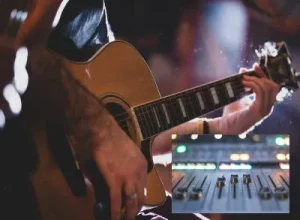When it comes to mixing music, whether in a studio or live setting, achieving a big and impactful guitar sound is crucial. Guitars play a significant role in adding energy and drive to a performance, but they can sometimes get lost in the mix. In this article, we will explore effective techniques to make guitars sound bigger in both studio and live mixes, ensuring they take center stage and captivate the audience.
Elements of a Big Guitar Sound
To create a larger-than-life guitar sound, it’s important to understand the elements that contribute to its presence in both studio and live mixes. Techniques such as layering, panning, and EQ can help achieve a wider and fuller guitar tone. By layering multiple guitar tracks in the studio, you can add depth and thickness to the sound when you are mixing guitars. Experiment with double tracking and harmonies to create a rich and layered effect. Additionally, utilizing EQ to shape the guitar tone, boosting the midrange frequencies, and cutting any unwanted frequencies can enhance the overall presence and impact of the guitars.
Layering Techniques
Layering is a powerful technique that can make guitars sound bigger in both studio and live mixes. In the studio, record multiple guitar parts and blend them together to achieve a thicker and more dynamic sound. Experiment with different guitar tones, playing styles, and pickup configurations to create interesting textures. In a live mix, consider using guitar effects processors and pedals to add depth and dimension to the sound that mimic the layering effect you can get in the studio. Utilize the stage setup and multiple guitar amps to create a massive wall of sound that envelops the audience.

Panning for Width and Stereo Imaging
Panning is an essential tool for creating a wide and spacious mix, whether in the studio or live. By strategically placing different guitar tracks at varying positions in the stereo field, you can achieve a sense of depth and separation. In the studio, experiment with panning rhythm guitar parts slightly to the left and right, while leaving the lead guitar in the center to maintain focus. In a live mix, position guitar amplifiers on opposite sides of the stage and pan them accordingly to create a wide stereo image that immerses the audience in the sound.
EQ Techniques for Enhancing Guitar Presence
EQ plays a critical role in shaping the guitar tone and bringing out its desired characteristics, both in studio and live mixes. Boosting the midrange frequencies can help the guitars cut through the mix and ensure their presence is felt. Pay attention to any harsh or muddy frequencies and use a narrow Q to cut them, allowing the guitars to sit more naturally in the mix. In a live mix, consider using a dedicated EQ for each guitar amplifier to sculpt the tone and eliminate any unwanted resonances that may occur in different venues.
Live Mixing
In a live mix, there are additional considerations to ensure guitars sound bigger and impactful. Experiment with microphone placement on guitar cabinets to capture the desired tone while minimizing bleed from other instruments. Utilize sound reinforcement techniques, such as delay and reverb effects, to create a sense of space and enhance the overall guitar sound. Continuously monitor and adjust the guitar levels during the performance to maintain a balanced mix that highlights the guitars’ presence.
Conclusion
By implementing these techniques, whether in the studio or live environment, you can elevate your guitar sound and make it bigger and more captivating. Experiment with layering, panning, EQ, and optimizing the guitar sound specifically for live settings to achieve the desired sound.

Leave a Reply